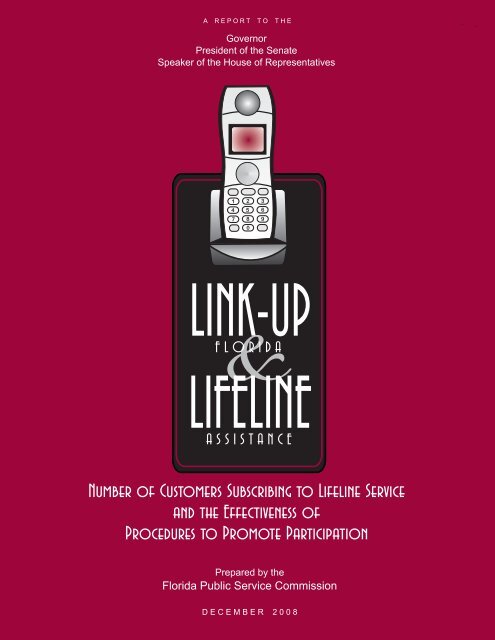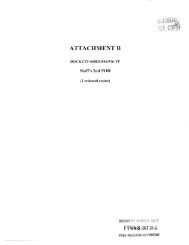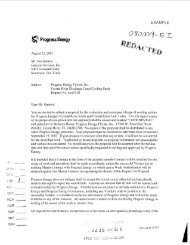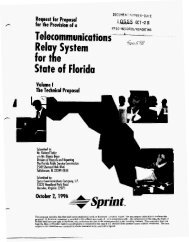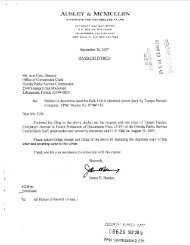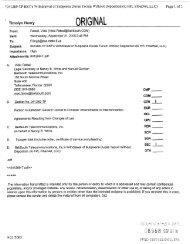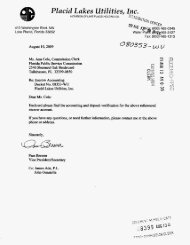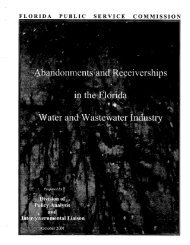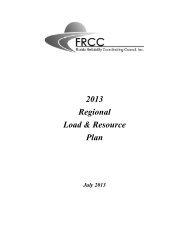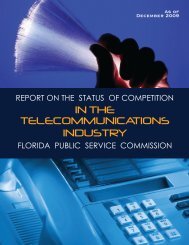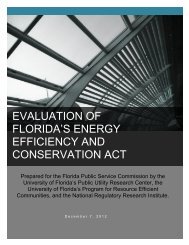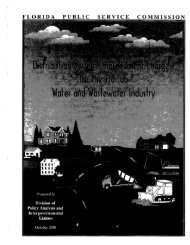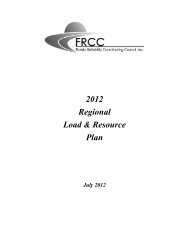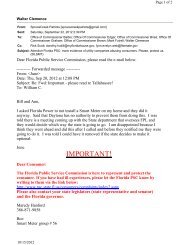Lifeline Report - Public Service Commission
Lifeline Report - Public Service Commission
Lifeline Report - Public Service Commission
You also want an ePaper? Increase the reach of your titles
YUMPU automatically turns print PDFs into web optimized ePapers that Google loves.
A REPORT TO THE<br />
Governor<br />
President of the Senate<br />
Speaker of the House of Representatives<br />
1 2 3<br />
4 5 6<br />
7 8 9<br />
0<br />
LINK-UP<br />
&<br />
FLORIDA<br />
LIFELINE<br />
ASSISTANCE<br />
Number of Customers Subscribing to <strong>Lifeline</strong> <strong>Service</strong><br />
and the Effectiveness of<br />
Procedures to Promote Participation<br />
Prepared by the<br />
Florida <strong>Public</strong> <strong>Service</strong> <strong>Commission</strong><br />
DECEMBER 2008
PREPARED BY<br />
The Florida <strong>Public</strong> <strong>Service</strong> <strong>Commission</strong><br />
Division of Regulatory Compliance<br />
Office of <strong>Public</strong> Information
Table of Contents<br />
List of Tables …………...……………………………………………..…………………………iv<br />
List of Acronyms……………………………………………………………………………….…v<br />
Executive Summary……………………………………………………………………………….1<br />
I. Background………….…………………………………………………………………….3<br />
II.<br />
III.<br />
IV.<br />
Program Support…………………………………………………………………………..3<br />
Customer Eligibility……………………………………………………………………….4<br />
Carrier Eligibility………………………………………………………………………….5<br />
V. Subscribership and Participation Rates…………………….………………….………….6<br />
A. <strong>Lifeline</strong>…….……….……………………………………………………….…………6<br />
B. Link-Up……..……….………………………………………………………………...9<br />
C. Transitional <strong>Lifeline</strong>….……………..………………………………………………..10<br />
VI.<br />
Regulatory Actions Impacting Florida’s <strong>Lifeline</strong> Program………….……....…………..10<br />
A. Florida <strong>Public</strong> <strong>Service</strong> <strong>Commission</strong>…………………………………..…………….10<br />
B. Office of <strong>Public</strong> Counsel……………………………………………………..……..15<br />
C. Federal Communications <strong>Commission</strong>………….……………………………….…16<br />
VII.<br />
VIII.<br />
IX.<br />
External <strong>Lifeline</strong> Research and Analysis…………………….………………………….17<br />
<strong>Lifeline</strong> Awareness Promotion, Pursuant to Section 364.10, Florida Statutes…………..18<br />
Effectiveness of Procedures to Promote Participation…………………………………..22<br />
X. Conclusion……………………………………………………………………………….23<br />
ii
List of Tables<br />
Table 1. Florida <strong>Lifeline</strong> Subscribership……………………………………………….….7<br />
Table 2. <strong>Lifeline</strong> Participation Rate in Florida.……………………………..……….…….7<br />
Table 3. <strong>Lifeline</strong> Net Participation…………………...……………………...…….….…....8<br />
Table 4. AT&T, Verizon, and Embarq Net <strong>Lifeline</strong> Customer Gain/Loss.…..……………9<br />
Table 5. AT&T, Verizon, and Embarq Link-Up Participants……………………………...9<br />
Table 6. AT&T, Verizon, and Embarq Transitional <strong>Lifeline</strong> Participants..…..…………..10<br />
Table 7. FPSC/DCF <strong>Lifeline</strong> Automatic Enrollment Applications…………..…….……..12<br />
iii
List of Acronyms<br />
AHCA<br />
AWI<br />
CFR<br />
CLEC<br />
CSF<br />
CMRS<br />
CPS<br />
DCF<br />
DTV<br />
ETC<br />
FAC<br />
FCC<br />
FNPRM<br />
FPG<br />
FPSC<br />
ILEC<br />
LIHEAP<br />
MOU<br />
NSL<br />
OPC<br />
PSAP<br />
PURC<br />
Agency for Health Care Administration<br />
Agency for Workforce Innovation<br />
Code of Federal Regulations<br />
Competitive Local Exchange Carrier<br />
Community <strong>Service</strong> Fund<br />
Commercial Mobile Radio <strong>Service</strong> (Wireless)<br />
Current Population Survey<br />
Department of Children and Families<br />
Digital Television<br />
Eligible Telecommunications Carrier<br />
Florida Administrative Code<br />
Federal Communications <strong>Commission</strong><br />
Further Notice of Proposed Rulemaking<br />
Federal Poverty Guidelines<br />
Florida <strong>Public</strong> <strong>Service</strong> <strong>Commission</strong><br />
Incumbent Local Exchange Carrier<br />
Low-Income Home Energy Assistance Plan<br />
Memorandum of Understanding<br />
National School Lunch Program’s Free Lunch Program<br />
Office of <strong>Public</strong> Counsel<br />
<strong>Public</strong> Safety Answering Point<br />
<strong>Public</strong> Utility Research Center<br />
iv
TLS<br />
USAC<br />
USF<br />
WFI<br />
Toll-Limitation <strong>Service</strong><br />
Universal <strong>Service</strong> Administrative Company<br />
Universal <strong>Service</strong> Fund<br />
Workforce Florida, Inc.<br />
v
Executive Summary<br />
The Tele-Competition Innovation and Infrastructure Enhancement Act of 2003 (the 2003<br />
Act) requires that a statewide cooperative effort be made to support the <strong>Lifeline</strong> Assistance<br />
Program (<strong>Lifeline</strong>) in Florida. This report presents participation data for the 2007-2008 program<br />
year. The report also evaluates procedures put in place to strengthen the program and increase<br />
the number of participants.<br />
During the 2007 legislative session, Section 364.10(3)(h)(2), Florida Statutes, was<br />
modified to require any state agency that determines a person is eligible for <strong>Lifeline</strong> service to<br />
immediately forward the information to the Florida <strong>Public</strong> <strong>Service</strong> <strong>Commission</strong> (FPSC or<br />
<strong>Commission</strong>) to ensure that the person is automatically enrolled in the <strong>Lifeline</strong> program. In<br />
April 2007, the FPSC and the Department of Children and Families (DCF), formally<br />
implemented an automatic <strong>Lifeline</strong> enrollment process. On September 25, 2007, the FPSC<br />
approved proposed amendments to Rule 25-4.0665, Florida Administrative Code (F.A.C.),<br />
<strong>Lifeline</strong> <strong>Service</strong>, to include the <strong>Lifeline</strong> automatic enrollment process. A Memorandum of<br />
Understanding with respect to the <strong>Lifeline</strong> automatic enrollment procedures was signed by the<br />
FPSC, DCF, and the Office of <strong>Public</strong> Counsel (OPC) on September 27, 2007. The 2007<br />
Legislature also granted a public records exemption for personal identifying information of<br />
<strong>Lifeline</strong> Assistance plan participants.<br />
The number of eligible customers participating in the <strong>Lifeline</strong> program in Florida grew<br />
11.8 percent during the October 2007 through June 2008 nine-month review period. 1 As of June<br />
2008, 183,972 eligible customers participated in the <strong>Lifeline</strong> program. Embarq Florida, Inc.<br />
(Embarq), and AT&T Florida f/k/a BellSouth (AT&T) experienced the largest increases in<br />
<strong>Lifeline</strong> participation among Florida’s ETCs during the 2007-2008 review period. Embarq<br />
increased its <strong>Lifeline</strong> participation by 4,787 customers, while AT&T’s participation increased by<br />
11,169 customers. Verizon experienced the largest net loss of <strong>Lifeline</strong> customers at 1,198.<br />
Consistent with 2007, the primary reason for the increase in <strong>Lifeline</strong> participation has<br />
been the automatic enrollment process initiated by the FPSC and the DCF. Between April 1,<br />
2007, and October 31, 2008, <strong>Lifeline</strong> applications totaling 268,797 were filed through the<br />
FPSC/DCF automatic enrollment process. In addition, enrollment of new <strong>Lifeline</strong> customers by<br />
competitive eligible telecommunications companies (ETC) continues to have a positive impact.<br />
In total, non-incumbent local exchange carrier (ILEC) <strong>Lifeline</strong> enrollment 2 was 13,843<br />
customers, representing 7.5 percent of the total <strong>Lifeline</strong> customer enrollment as of June 30, 2008.<br />
Furthermore, TracFone Wireless began serving <strong>Lifeline</strong> customers in Florida on<br />
September 8, 2008. Since <strong>Lifeline</strong> enrollment figures in this report are for a nine-month period<br />
ending June 30, 2008, TracFone’s <strong>Lifeline</strong> customers are not included in the total number of<br />
<strong>Lifeline</strong> customers. TracFone enrolled 65,000 new <strong>Lifeline</strong> customers from September 8, 2008,<br />
to November 5, 2008, which brings total Florida <strong>Lifeline</strong> customers to approximately 250,000,<br />
1 The 2008 <strong>Lifeline</strong> <strong>Report</strong> uses a nine-month review period to establish an earlier date for data collection. Future<br />
reports will return to a twelve-month review period (July 1-June 30).<br />
2 Non-ILEC <strong>Lifeline</strong> enrollment includes competitive ETC and non-ETC reseller enrollment.<br />
1
which would represent approximately 21 percent of all <strong>Lifeline</strong> eligible households in Florida.<br />
TracFone’s ETC designation is discussed further on pages 13-14 of this report.<br />
The need for <strong>Lifeline</strong> assistance continues to grow in Florida. According to a U.S.<br />
Department of Agriculture <strong>Report</strong>, Florida had the largest nationwide increase in households<br />
participating in the Food Stamp Program at 21.8 percent from July 2007 to June 2008. 3 The<br />
Food Stamp Program is the largest qualifying program for <strong>Lifeline</strong> assistance.<br />
The FPSC remains committed to improving the success of the Link-Up and <strong>Lifeline</strong><br />
programs. In addition, efforts to improve the effectiveness of the FPSC/DCF automatic<br />
enrollment process will continue, as will efforts to increase public awareness of the <strong>Lifeline</strong><br />
program through targeted consumer outreach. This report provides greater detail on these and<br />
other initiatives and developments.<br />
3 http://www.fns.usda.gov/pd/30fslatehh.htm<br />
2
I. Background<br />
The Tele-Competition Innovation and Infrastructure Enhancement Act of 2003 (the 2003<br />
Act) became law on May 23, 2003, by the signature of the Governor. The 2003 Act requires that<br />
each state agency providing benefits to persons eligible for the <strong>Lifeline</strong> Assistance Program<br />
(<strong>Lifeline</strong>) shall, in cooperation with the Department of Children and Families (DCF), the Florida<br />
<strong>Public</strong> <strong>Service</strong> <strong>Commission</strong> (FPSC or <strong>Commission</strong>), and telecommunications companies<br />
providing <strong>Lifeline</strong> service, develop procedures to promote participation in <strong>Lifeline</strong>. The 2003<br />
Act further requires the FPSC to report to the Governor, the President of the Senate, and the<br />
Speaker of the House of Representatives by December 31 each year on the number of customers<br />
subscribing to <strong>Lifeline</strong> service and the effectiveness of procedures to promote participation in<br />
the program. 4 This report is prepared pursuant to the requirements of the 2003 Act.<br />
As highlighted in the 2007 <strong>Lifeline</strong> <strong>Report</strong>, key legislation was passed during the 2007<br />
legislative session to increase participation in the <strong>Lifeline</strong> program through automatic<br />
enrollment. The legislation requires any state agency that determines a person is eligible for<br />
<strong>Lifeline</strong> services must forward the information to the FPSC for automatic enrollment in the<br />
<strong>Lifeline</strong> program. Furthermore, the FPSC, the DCF, and the Office of <strong>Public</strong> Counsel (OPC)<br />
were required to enter into a Memorandum of Understanding (MOU) with respect to automatic<br />
enrollment.<br />
The FPSC, DCF, OPC, and industry have worked together to successfully implement the<br />
automatic enrollment process during 2008. Automatic enrollment has had a positive impact on<br />
enrollment, and the FPSC anticipates continued success in the future.<br />
II.<br />
Program Support<br />
The Florida Link-Up and <strong>Lifeline</strong> programs are part of the federal Universal <strong>Service</strong><br />
Program designed to enable low-income households to obtain and maintain basic local telephone<br />
service. Under the Federal Communications <strong>Commission</strong>’s (FCC) rules, there are four tiers of<br />
monthly federal <strong>Lifeline</strong> support.<br />
• The first tier of federal support is a $6.50 monthly credit for the federal subscriber<br />
line charge, which is available to all eligible subscribers. All fifty states have<br />
approved this tier of support.<br />
• The second tier of federal support is a $1.75 monthly credit that is available to<br />
subscribers in those states that have approved the credit. All fifty states have also<br />
approved this tier of support.<br />
• The third tier of federal support is one-half the amount of additional state support up<br />
to a maximum of $1.75 in federal support. Because Florida carriers provide an<br />
additional $3.50 credit to <strong>Lifeline</strong> customers’ bills, 5 Florida <strong>Lifeline</strong> subscribers<br />
4 Section 364.10, Florida Statutes.<br />
5 Since Florida does not have a state Universal <strong>Service</strong> Fund, the $3.50 credit is absorbed by the ETC providing<br />
service.<br />
3
currently receive a total monthly credit of at least $13.50, consisting of $10.00 ($6.50,<br />
$1.75, and $1.75) in federal support and $3.50 in state support. The telephone<br />
subscriber may receive a credit less than $13.50 if the subscriber’s bill for basic local<br />
telephone service is less than the maximum available credit.<br />
• The fourth tier of support, available only to eligible subscribers living on tribal lands,<br />
provides an additional credit up to $25.00 per month. This amount is limited to the<br />
extent that the credit does not bring the basic local residential rate below $1.00 per<br />
month.<br />
Link-Up, a companion program, provides a 50 percent reduction in the telephone service<br />
installation charge, up to a maximum $30 reduction. Eligible residents of tribal lands may<br />
receive up to $100 in discounts on initial connection charges. The $100 maximum is based on<br />
the sum of the federally financed 50 percent discount (up to the $30 maximum) available to all<br />
qualified low-income individuals, plus a dollar-for-dollar match (up to $70) for connection<br />
charges above $60.<br />
Transitional <strong>Lifeline</strong> Assistance requires that ETCs provide former <strong>Lifeline</strong> customers a<br />
30 percent discount off the residential basic local service rate. 6 The customer may receive the<br />
subsidy for one year from the date the customer ceases to be qualified for <strong>Lifeline</strong>.<br />
III.<br />
Customer Eligibility<br />
Program-Based<br />
Eligibility for both Link-Up and <strong>Lifeline</strong> in Florida can be determined by customer<br />
enrollment in any one of the following programs:<br />
• Temporary Cash Assistance (TCA) 7<br />
• Supplemental Security Income (SSI)<br />
• Food Stamps<br />
• Medicaid<br />
• Federal <strong>Public</strong> Housing Assistance (Section 8)<br />
• Low-Income Home Energy Assistance Plan (LIHEAP)<br />
• National School Lunch (NSL) Program’s Free Lunch Program 8<br />
• Bureau of Indian Affairs Programs 9<br />
6 Section 364.105, Florida Statutes.<br />
7 Known as Temporary Assistance to Needy Families (TANF) for federal universal service purposes.<br />
8 By Order No. PSC-06-0680-PAA-TL, issued August 7, 2006, in Docket No. 040604-TL, the FPSC required all<br />
ETCs to adopt the NSL for determining eligibility in the Link-Up and <strong>Lifeline</strong> programs in Florida.<br />
9 Eligible consumers living on tribal lands qualify for <strong>Lifeline</strong> if they participate in one of the following federal<br />
assistance programs: (1) Tribal TANF, (2) National School Lunch Free Lunch Program, or (3) Head Start Subsidy.<br />
4
Income-Based<br />
In addition to the program-based criteria, customers with annual incomes up to 135<br />
percent of the Federal Poverty Guidelines (FPG) may be eligible to participate in the Florida<br />
Link-Up and <strong>Lifeline</strong> programs. The OPC certifies customer eligibility under the income test for<br />
customers requesting to be enrolled in the <strong>Lifeline</strong> program. 10<br />
IV.<br />
Carrier Eligibility<br />
Section 54.201(b) of the Code of Federal Regulations (CFR) provides that a state<br />
commission shall, upon its own motion or upon request, designate a common carrier that meets<br />
certain requirements as an eligible telecommunications carrier (ETC) in a non-rural service area.<br />
Section 54.201(c) of the CFR provides that a state commission may, as long as the request is<br />
consistent with the public interest, convenience, and necessity, designate one or more common<br />
carrier(s) as ETC(s) in a rural service area. 11<br />
An ETC can be an incumbent local exchange carrier (ILEC), a competitive local<br />
exchange carrier (CLEC), or a wireless carrier. A carrier that is granted ETC status is eligible to<br />
receive universal service support 12 pursuant to FCC rules. 13 To qualify as an ETC, a common<br />
carrier must offer services that are supported by federal universal service support mechanisms,<br />
either using its own facilities or a combination of its own facilities and another carrier’s resold<br />
service. 14 Additionally, the carrier must advertise the availability of such services and charges<br />
using mass media.<br />
The following companies have been granted ETC status in Florida: 15<br />
• AT&T<br />
• Verizon<br />
• Embarq<br />
• FairPoint Communications (formerly GTC, Inc.)<br />
10 See Section 364.10(3)(a), Florida Statutes.<br />
11 A state commission also has the authority to rescind the ETC status of any ETC designated by it that does not<br />
follow the requirements of the <strong>Lifeline</strong> Assistance program.<br />
12 Universal <strong>Service</strong> support is provided to ETCs for providing <strong>Lifeline</strong> service; rendering service to schools and<br />
libraries; and provisioning, maintaining, and upgrading facilities and services for rural, insular (islands that are<br />
territories or commonwealths of the United States), and high cost areas.<br />
13 47 CFR pt. 54 – Universal <strong>Service</strong>.<br />
14 Those services supported by Universal <strong>Service</strong> include the following: (1) voice grade access to the public<br />
switched network, (2) an amount of local minutes of use of local exchange service provided free of charge to end<br />
users, (3) dual tone multi-frequency signaling or its functional equivalent, (4) single-party service, (5) access to<br />
emergency services, (6) access to operator services, (7) access to interexchange services, (8) access to directory<br />
assistance, and (9) toll limitation for qualifying low-income consumers.<br />
15 The FCC designated Alltel Wireless and Sprint Nextel as ETCs. The remaining ETCs were designated by the<br />
FPSC. The following Florida ETC petition is pending before the FCC: Southern Communications <strong>Service</strong>s, Inc.,<br />
d/b/a Southern LINC. The following Florida ETC petitions are pending before the FPSC: Swiftel, LLC.; BLC<br />
Management, LLC, d/b/a Angles Communications Solutions; Express Phone <strong>Service</strong>, Inc.; Image Access, Inc. d/b/a<br />
NewPhone; and Tele Circuit Network Corporation.<br />
5
• Windstream<br />
• TDS Telecom<br />
• NEFCOM<br />
• Frontier<br />
• ITS Telecom<br />
• Smart City<br />
• ALLTEL Wireless<br />
• Sprint-Nextel<br />
• Knology of Florida, Inc.<br />
• Budget Phone, Inc.<br />
• Nexus Communications, Inc.<br />
• Ganoco, Inc. d/b/a American Dial Tone<br />
• Midwestern Telecommunications, Inc.<br />
• dPi Teleconnect, LLC<br />
• TracFone d/b/a SafeLink Wireless<br />
• FLATEL, Inc.<br />
The FCC designated Sprint-Nextel and ALLTEL as ETCs. In approving the designation<br />
of Commercial Mobile Radio <strong>Service</strong> (CMRS) carriers as ETCs, the FCC noted that ETCs must<br />
comply with state requirements in states that have <strong>Lifeline</strong> programs. 16 By Order No. PSC-07-<br />
0288-PAA-TP, issued April 3, 2007, the FPSC found that it had authority to consider<br />
applications for ETC status by CMRS providers.<br />
V. Subscribership and Participation Rates<br />
A. <strong>Lifeline</strong><br />
Table 1 shows the number of <strong>Lifeline</strong> subscribers from December 2003 through June<br />
2008. The increase in <strong>Lifeline</strong> subscribers in 2008 is the result of continued successful<br />
implementation of the FPSC/DCF automatic enrollment process. The new process is discussed<br />
in greater detail in Chapter VI of this report. The decrease in <strong>Lifeline</strong> subscribers in 2005 was<br />
primarily the result of <strong>Lifeline</strong> customers determined to be ineligible by AT&T as a result of<br />
AT&T’s implementation of federally mandated annual eligibility verification procedures. In<br />
compliance with FCC Order No. 04-87, 17 and Order No. PSC-04-0781-PAA-TL, issued August<br />
10, 2004, 18 all of Florida’s ETCs have established <strong>Lifeline</strong> verification procedures to verify the<br />
continued eligibility of consumers.<br />
16 FCC Nextel Order, DA 04-2667, adopted August 25, 2004, footnote 30; FCC ALLTEL Order, DA 04-3046,<br />
adopted September 24, 2004, footnote 29; FCC Sprint Order, DA 04-3617, adopted November 18, 2004, footnote<br />
27.<br />
17 <strong>Report</strong> and Order and Further Notice of Proposed Rulemaking, WC Docket 03-109, In the Matter of <strong>Lifeline</strong> and<br />
Link-Up, Order No. FCC 04-87, paragraphs 33-34 (released April 29, 2004).<br />
18 In RE: Adoption of the National School Lunch Program and an income-based criterion at or below 135 percent of<br />
the Federal Poverty guidelines as eligibility criteria for the <strong>Lifeline</strong> and Link-Up programs.<br />
6
Table 1. Florida <strong>Lifeline</strong> Subscribership<br />
December September September September September June<br />
2003 2004 2005 2006 2007 2008<br />
<strong>Lifeline</strong><br />
Subscribers<br />
148,905 154,019 139,261 145,734 164,626 183,972 19<br />
The number of customers enrolled in <strong>Lifeline</strong> increased by 19,346 consumers during the<br />
2007-2008 nine-month review period, representing an 11.8 percent increase. If TracFone’s<br />
enrollment numbers were included in Table 1, the increase would be 84,346 consumers,<br />
representing a 52 percent increase. The implementation of the FPSC/DCF automatic enrollment<br />
process continues to have a positive impact on participation.<br />
Table 2 shows <strong>Lifeline</strong> participation rates for December 2003 through June 2008. 20 As of<br />
June 2008, the participation rate was 15.5 percent. If TracFone enrollment figures were included<br />
in Table 2, the participation rate would be 21 percent of eligible households.<br />
Table 2. <strong>Lifeline</strong> Participation Rate in Florida<br />
Year<br />
<strong>Lifeline</strong><br />
Enrollment<br />
Eligible<br />
Households<br />
% Participation Rate<br />
<strong>Lifeline</strong> Enrollment<br />
Eligible Households<br />
June 2008 183,972 1,186,015 15.5 21<br />
September 2007 164,626 1,173,173 14.0<br />
September 2006 145,734 1,150,483 12.7<br />
September 2005 139,261 1,122,593 12.4<br />
September 2004 154,019 1,100,000 14.0<br />
December 2003 148,905 819,112 18.2<br />
Sources: FCC’s State-by-State Telephone Revenues and Universal <strong>Service</strong> Data (September 2003);<br />
Department of Children and Families (DCF); <strong>Report</strong> and Order and Further Notice of Proposed<br />
Rulemaking, WC Docket 03-109, In the Matter of <strong>Lifeline</strong> and Link-Up, Order No. FCC 04-87,<br />
Released April 29, 2004; Universal <strong>Service</strong> Administrative Company responses to FPSC data requests<br />
(2004); and industry responses to FPSC data requests (2003-2008).<br />
19 <strong>Lifeline</strong> subscribership would be 248,972 with the inclusion of TracFone.<br />
20 The participation rate is the ratio of enrolled subscribers to the eligible population.<br />
21 The participation rate would be 21 percent with the inclusion of TracFone.<br />
7
Table 3 represents the distribution of <strong>Lifeline</strong> enrollment from December 2003 to June<br />
2008. The data show a net increase of 11.8 percent <strong>Lifeline</strong> subscribers. 22<br />
Table 3. <strong>Lifeline</strong> Net Participation<br />
Net Net Net Net Net<br />
ETCs Dec Sept Growth Sept Growth Sept Growth Sept Growth June Growth<br />
2003 2004 Rate 2005 Rate 2006 Rate 2007 Rate 2008 Rate<br />
AT&T 103,681 104,467 1% 86,408 - 17% 87,291 1% 93,337 7% 104,506 12.0%<br />
Verizon 22,295 23,642 6% 24,433 3% 26,428 8% 23,918 - 9% 22,720 - 5.0%<br />
Embarq 16,736 19,274 15% 21,537 12% 23,104 7% 30,016 30% 34,803 15.9%<br />
FairPoint 2,385 2,304 - 3% 2,096 - 9% 2,002 - 4% 2,030 1% 2,179 7.3%<br />
Windstream 2,670 3,067 15% 3,322 8% 3,533 6% 3,806 8% 4,266 12.1%<br />
TDS<br />
Telecom<br />
496 571 15% 657 15% 697 6% 736 6% 735 - 0.1%<br />
NEFCOM 510 561 10% 630 12% 588 - 7% 635 8% 638 0.5%<br />
Frontier 104 104 0% 120 15% 118 - 2% 150 27% 172 14.7%<br />
ITS Telecom 27 27 0% 26 - 4% 27 4% 79 193% 101 27.8%<br />
Smart City 1 2 100% 5 150% 3 - 40% 8 167% 9 12.5%<br />
ALLTEL<br />
Wireless<br />
N/A N/A N/A 13 N/A 31 138% 38 23% 32 - 15.8%<br />
Sprint Nextel N/A N/A N/A 14 N/A 28 100% 39 39% 78 100.0%<br />
Knology N/A N/A N/A 0 N/A 64 N/A 126 97% 221 75.4%<br />
Budget<br />
Phone<br />
American<br />
Dial Tone<br />
N/A N/A N/A N/A N/A 134 N/A 59 - 56% 565 857.6%<br />
N/A N/A N/A N/A N/A 1,166 N/A 1,840 58% 1,847 0.4%<br />
Nexus N/A N/A N/A N/A N/A 0 N/A 2037 N/A 2,084 2.3%<br />
Vilaire<br />
N/A N/A N/A N/A N/A 520 N/A 5,598 997% N/A 23 N/A<br />
Midwestern N/A N/A N/A N/A N/A 0 N/A 174 N/A 465 167.2%<br />
Non-ETC<br />
Reseller*<br />
N/A N/A N/A N/A N/A N/A N/A N/A N/A 8,551 N/A<br />
Total 148,905 154,019 3.4% 139,261 -9.6% 145,734 5% 164,626 13% 183,972 11.8%<br />
* Non-ETC Resellers were previously included within the above ETCs.<br />
Sources: Industry responses to FPSC data requests (2003-2008); Universal <strong>Service</strong> Administrative Company responses to FPSC data request<br />
(2004 and 2005).<br />
22 The participation decrease in 2005 was primarily the result of AT&T’s implementation of verification procedures,<br />
which eliminated <strong>Lifeline</strong> subscribers who could not present proof of eligibility.<br />
23 Vilaire’s certificate to provide service in Florida was canceled by the FPSC in 2008.<br />
8
AT&T and Embarq experienced the largest increases in <strong>Lifeline</strong> participation among<br />
Florida’s ETCs during the 2007-2008 nine-month review period. As presented in Table 4, the<br />
three largest ETCs had a net <strong>Lifeline</strong> customer gain of 14,758.<br />
Table 4. AT&T, Verizon, and Embarq<br />
Net <strong>Lifeline</strong> Customer Gain/Loss<br />
October 2007 – June 2008<br />
Company<br />
Net <strong>Lifeline</strong><br />
Customer Gain/Loss<br />
AT&T 11,169<br />
Verizon (1,198)<br />
Embarq 4,787<br />
Total 14,758<br />
Source: Industry responses to FPSC data requests (2005-2008).<br />
B. Link-Up<br />
Florida’s Link-Up program helps low-income consumers by reducing the telephone<br />
service installation charge. This program pays one-half (up to a maximum of $30) of the initial<br />
installation fee for a traditional wireline telephone or activation fee for a wireless telephone.<br />
Eligible residents of tribal lands may receive up to $100 in discounts on initial connection<br />
charges. The $100 maximum is based on the sum of the federally financed 50 percent discount<br />
(up to the $30 maximum) available to all qualified low-income individuals, plus a dollar-fordollar<br />
match (up to $70) for connection charges above $60.<br />
Table 5 displays Link-Up program participants for AT&T, Verizon, and Embarq from<br />
2005 through 2008.<br />
Table 5. AT&T, Verizon, and Embarq<br />
Link-Up Participants<br />
Year<br />
AT&T, Verizon, and Embarq<br />
Link-Up Customers<br />
September 2005 11,605<br />
September 2006 15,353<br />
September 2007 29,849<br />
June 2008 13,959<br />
Source: Industry responses to FPSC data requests (2005-2008).<br />
9
C. Transitional <strong>Lifeline</strong><br />
In accordance with Section 364.105, Florida Statutes, current customers who no longer<br />
meet eligibility criteria and are removed from <strong>Lifeline</strong> service receive a 30 percent discount off<br />
the residential basic local service rate for a period of 12 months after <strong>Lifeline</strong> service is removed.<br />
For example, a former <strong>Lifeline</strong> customer with a phone bill that includes a $25.00 basic rate<br />
would receive a $7.50 monthly discount for one year. Progressing from <strong>Lifeline</strong> service means<br />
that the consumer’s socio-economic status may have improved, and the customer may have<br />
advanced beyond the qualifying eligibility criteria. Table 6 presents data on Transitional <strong>Lifeline</strong><br />
customers for AT&T, Verizon, and Embarq for September 2005 through June 2008.<br />
Table 6. AT&T, Verizon, and Embarq<br />
Transitional <strong>Lifeline</strong> Participants<br />
Year<br />
AT&T, Verizon, and Embarq<br />
Participants<br />
September 2005 16,372<br />
September 2006 21,173<br />
September 2007 11,463<br />
June 2008 8,822<br />
Source: Industry responses to FPSC data requests (2005-2008).<br />
VI.<br />
Regulatory Actions Impacting Florida’s <strong>Lifeline</strong> Program<br />
Key regulatory initiatives undertaken by the FPSC, the OPC, and the FCC to promote the<br />
Link-Up and <strong>Lifeline</strong> programs continued during 2008. A discussion on these issues and<br />
dockets, including relevant background information, is presented below.<br />
A. Florida <strong>Public</strong> <strong>Service</strong> <strong>Commission</strong><br />
1. Proposed amendment of Rule 25-4.0665, F.A.C., <strong>Lifeline</strong> <strong>Service</strong> (Docket No.<br />
070572-TL). Section 364.10(3)(h)(2), Florida Statutes, as amended during the 2007 Legislative<br />
Session, requires any state agency that determines a person is eligible for <strong>Lifeline</strong> service to<br />
immediately forward the information to the FPSC to ensure that the person is automatically<br />
enrolled in the <strong>Lifeline</strong> program. This section required the FPSC to adopt rules by December 31,<br />
2007, creating procedures to automatically enroll eligible customers in <strong>Lifeline</strong> service.<br />
On September 25, 2007, the FPSC approved proposed amendments to Rule 25-4.0665,<br />
F.A.C., <strong>Lifeline</strong> <strong>Service</strong>, which were effective December 6, 2007. During 2008, the FPSC<br />
continued <strong>Lifeline</strong> rulemaking to develop additional rules for Florida’s Link-Up and <strong>Lifeline</strong><br />
programs, which include certification, verification, data reporting, and a host of other issues. A<br />
rule development workshop was held on November 5, 2008, to address the additional <strong>Lifeline</strong><br />
rulemaking.<br />
10
2. <strong>Lifeline</strong> Automatic Enrollment Process. In April 2007, the FPSC and the DCF<br />
formally implemented a process whereby the names of potential <strong>Lifeline</strong> customers, once<br />
certified through a DCF program, would be automatically forwarded to the FPSC, and ultimately<br />
to the respective ETC for possible enrollment.<br />
The automatic enrollment process entails the DCF client checking a “yes” or “no” box on<br />
the DCF Web application, indicating an interest in receiving the <strong>Lifeline</strong> discount on his or her<br />
telephone service. The “no” box provides an option to the applicant not to subscribe to <strong>Lifeline</strong>.<br />
If the client answers in the affirmative, the applicant identifies a telephone service provider from<br />
a drop-down box on the application and answers applicable questions. The DCF forwards to the<br />
FPSC the necessary information of those clients approved by DCF for benefits who have<br />
indicated their desire to receive the <strong>Lifeline</strong> discount. The FPSC computers electronically sort<br />
the information by ETC and place the applications on the FPSC’s secure Web site for retrieval<br />
by the appropriate ETC.<br />
All ETCs are required to enroll the subscriber in the program as soon as practicable, but<br />
no later than 60 days from the receipt of the FPSC’s automatic e-mail notification. In addition,<br />
upon completion of initial enrollment, the ETC is required to credit the subscriber’s bill for<br />
<strong>Lifeline</strong> service as of the date the ETC received the FPSC’s e-mail notification.<br />
ETCs are required to provide the FPSC, within 20 calendar days of receiving the FPSC’s<br />
e-mail notification, the names, addresses, telephone numbers, and date of the application for any<br />
misdirected applications; any applications for customers currently receiving <strong>Lifeline</strong> service; or<br />
any rejected applicants, including the reason(s) the applicants were rejected. The information<br />
filed by the ETCs is confidential and exempt from the public records requirement; however, the<br />
information contained in the response is disclosed to the <strong>Commission</strong>, pursuant to the criteria set<br />
forth in Section 364.107(3)(a)(4), Florida Statutes.<br />
Staff began formally tracking the number of <strong>Lifeline</strong> applications filed via the DCF<br />
automatic enrollment process in April 2007, and to date <strong>Lifeline</strong> applications totaling 268,797<br />
were filed through the FPSC/DCF automatic enrollment process. As presented in Table 7,<br />
between April 2007 and October 2008, 175,322 eligible <strong>Lifeline</strong> applications were filed through<br />
the FPSC/DCF automatic enrollment process. However, not all applications result in new<br />
<strong>Lifeline</strong> customers added, and the difference of 93,475 were rejected applications. Several of the<br />
more common reasons for rejected applications include: (1) customer already on <strong>Lifeline</strong>, (2)<br />
customer receives service from a non-ETC service provider, and (3) an inaccurate or incomplete<br />
application.<br />
The implementation of the <strong>Lifeline</strong> automatic enrollment process has shown promising<br />
results; furthermore, the potential to reach significantly greater numbers of eligible customers<br />
through automatic enrollment exists. Considerable staff resources and time have been allocated<br />
to implementing the process to date. If the newly implemented system is to reach its full<br />
potential, the FPSC believes a sustained effort is necessary.<br />
11
Table 7. FPSC/DCF <strong>Lifeline</strong> Automatic<br />
Enrollment Applications per Month<br />
April 2007 – October 2008<br />
Month<br />
Applications<br />
October 2008 13,262<br />
September 2008 16,497<br />
August 2008 12,400<br />
July 2008 12,335<br />
June 2008 11,497<br />
May 2008 9,743<br />
April 2008 9,579<br />
March 2008 9,372<br />
February 2008 4,905<br />
January 2008 6,303<br />
December 2007 6,540<br />
November 2007 5,387<br />
October 2007 5,768<br />
September 2007 6,252<br />
August 2007 7,940<br />
July 2007 10,684<br />
June 2007 9,949<br />
May 2007 8,535<br />
April 2007 8,374<br />
Total 175,322<br />
Source: Industry responses to FPSC data requests [2005-2008].<br />
3. Bundled Packages. Docket No. 080234-TP addresses the application of the <strong>Lifeline</strong><br />
discount to bundled service packages. A bundled service package combines basic local<br />
exchange service with nonbasic services to create an enhanced service offering. Nonbasic<br />
services include call waiting, call forwarding, voice mail, Internet access, and all other services<br />
that may be offered in a bundled package which includes basic service.<br />
Currently, ETC policies within Florida differ as to whether the <strong>Lifeline</strong> discount applies<br />
to bundled service packages. Some ETCs provide <strong>Lifeline</strong> consumers with the option to<br />
subscribe to any bundled package while others reject the applications of <strong>Lifeline</strong> consumers<br />
subscribing to bundled services. Other ETCs engage in procedures informing consumers of their<br />
limited plans for <strong>Lifeline</strong>, giving them the only option of subscribing to a basic service.<br />
The FPSC initiated this action because Florida consumers who have been qualified for<br />
the <strong>Lifeline</strong> program through the FPSC/DCF <strong>Lifeline</strong> automatic enrollment process are being<br />
denied <strong>Lifeline</strong> service by some providers because of the consumer’s choice for a bundled<br />
service. As an example, over 7,800 consumers were denied <strong>Lifeline</strong> service by Verizon because<br />
of Verizon’s policy of not allowing a <strong>Lifeline</strong> discount on bundled packages.<br />
12
Sprint-Nextel and Alltel each offer only one basic package for <strong>Lifeline</strong> service. Consumers who<br />
want to receive the <strong>Lifeline</strong> discount are not allowed to choose other bundled packages with<br />
more features. These two wireless ETCs reported over 3 million customers in Florida, received<br />
over 13,000 <strong>Lifeline</strong> applications through the FPSC/DCF <strong>Lifeline</strong> automatic enrollment process,<br />
but reported only 110 <strong>Lifeline</strong> customers between them for this report because of their policy of<br />
denying a <strong>Lifeline</strong> discount on all bundled packages.<br />
By Order No. PSC-08-0417-PAA-TP, issued June 23, 2008, the <strong>Commission</strong> clarified<br />
that pursuant to 47 C.F.R. §54.403(b) and consistent with Chapter 364, Florida Statutes, ETCs<br />
are required to apply the <strong>Lifeline</strong> discount to the basic local service rate or the basic local service<br />
rate portion of any service offering which combines both basic and nonbasic service.<br />
Verizon Florida, LLC (Verizon), NPCR, Inc. d/b/a Nextel Partners and Sprint<br />
Corporation n/k/a Sprint Nextel Corporation d/b/a Sprint PCS (Sprint Nextel), and Alltel<br />
Communications, LLC (Alltel) each filed timely requests for formal proceedings in protest of the<br />
FPSC’s order. On July 16, 2008, the Office of <strong>Public</strong> Counsel (OPC) filed a Notice of<br />
Intervention in support of the FPSC’s order. The matter has been scheduled for a formal hearing<br />
on February 24, 2009.<br />
4. <strong>Lifeline</strong> Research (Docket No. 070567-TL). On August 22, 2007, AT&T and<br />
Embarq filed a Joint Petition requesting that the FPSC clarify the use of Community <strong>Service</strong><br />
Funds. 24 The Joint Petition requested that monies from this fund be used to retain the <strong>Public</strong><br />
Utility Research Center (PURC) to conduct research activities on <strong>Lifeline</strong> participation.<br />
In November 2007, the FPSC decided that in addition to using the <strong>Lifeline</strong> Community<br />
<strong>Service</strong> Fund (CSF) to educate and promote Link-Up and <strong>Lifeline</strong> services, the fund can be used<br />
to support research activities which are in the public interest and designed to benefit Link-Up<br />
and <strong>Lifeline</strong> service. 25 The PURC report titled “More than a <strong>Lifeline</strong>: Low-Income Households’<br />
Telecommunications Preferences” was issued April 4, 2008, and is discussed in detail in Chapter<br />
VII of this report.<br />
5. TracFone d/b/a Safelink Wireless Application for Designation as an Eligible<br />
Telecommunications Carrier for the Limited Purpose of Offering <strong>Lifeline</strong> <strong>Service</strong> (Docket<br />
No. 070586-TP). By Order No. PSC-08-0418-PAA-TP, issued June 23, 2008, the <strong>Commission</strong><br />
granted TracFone Wireless statewide ETC status in Florida for the limited purpose of offering<br />
<strong>Lifeline</strong> service to qualified households. The FPSC made the designation contingent on<br />
providing certification from each <strong>Public</strong> Safety Answering Point (PSAP) in Florida to which<br />
TracFone has the ability to provide its <strong>Lifeline</strong> customers with access to basic and E-911<br />
services. On September 8, 2008, TracFone completed its PSAP certification process and became<br />
an ETC. TracFone’s <strong>Lifeline</strong> offering includes a free handset and 68 minutes of free airtime.<br />
The <strong>Lifeline</strong> customer’s account will be automatically credited with 68 minutes of airtime each<br />
24 The FPSC, the OPC, and the ILECs have worked together to create Community <strong>Service</strong> Funds to be used to<br />
educate customers about and promote <strong>Lifeline</strong> and Link-Up. Through a series of stipulated agreements and<br />
settlements, funding mechanisms have been established by AT&T, Embarq, and Windstream to make contributions<br />
into the CSF for service quality violations.<br />
25 Order PSC-07-0919-PAA-TL, issued November 14, 2007, in Docket No. 070567-TL.<br />
13
month which can carry over to the next month if not completely used.<br />
TracFone has enrolled over 65,000 Florida consumers in its <strong>Lifeline</strong> program as of<br />
November 5, 2008. This number is not included in the total <strong>Lifeline</strong> Net Participation in Table 3<br />
since the table numbers reflect subscribership through June 30, 2008. However, if TracFone’s<br />
enrollment numbers were added, total <strong>Lifeline</strong> customers would be 248,972, and the net growth<br />
rate would be 20.99 percent.<br />
6. FLATEL Application for Designation as an Eligible Telecommunications Carrier<br />
for the Limited Purpose of Offering <strong>Lifeline</strong> <strong>Service</strong> (Docket No. 070683-TX). By Order No.<br />
PSC-08-0631-PAA-TX, issued September 24, 2008, the <strong>Commission</strong> granted FLATEL, Inc.<br />
ETC status in Florida for the limited purpose of offering <strong>Lifeline</strong> service to qualified households.<br />
The designation was granted for the non-rural areas of AT&T and Verizon service territories.<br />
7. dPi Teleconnect, LLC Application for Designation as an Eligible Telecommunications<br />
Carrier for the Limited Purpose of Offering <strong>Lifeline</strong> <strong>Service</strong>. (Docket No.<br />
080043-TX). By Order No. PSC-08-0630-PAA-TX, issued September 24, 2008, the<br />
<strong>Commission</strong> granted dPi Teleconnect, LLC ETC status in Florida for the limited purpose of<br />
offering <strong>Lifeline</strong> service to qualified households. The designation was granted for the non-rural<br />
areas of AT&T and Verizon service territories.<br />
8. Investigation of Vilaire Communications, Inc.’s (VCI) Eligible Telecommunications<br />
Carrier Status and Competitive Local Exchange Company Certificate<br />
Status in the State of Florida (Docket No. 080065-TX). On May 22, 2006, the FPSC<br />
designated VCI as an ETC in AT&T’s service area 26 solely to provide Link-Up and <strong>Lifeline</strong><br />
services to low-income Florida consumers. As part of the FPSC’s ongoing effort to monitor<br />
Universal <strong>Service</strong> Funds being distributed to ETCs in Florida, the FPSC reviews the Universal<br />
<strong>Service</strong> Administrative Company’s (USAC) disbursement database on a monthly basis. Because<br />
of the rapid growth in <strong>Lifeline</strong> customers served by VCI, 27 and the FPSC’s commitment to<br />
monitor Universal <strong>Service</strong> Funds received by ETCs, an investigation of VCI’s practices was<br />
initiated. The investigation found that VCI was overpaid $1,319,775 from the federal Universal<br />
<strong>Service</strong> Fund (USF) for Florida through the Link-Up, <strong>Lifeline</strong>, and toll-limitation service (TLS)<br />
programs from August 2006 through December 2007. It was also determined that VCI<br />
overcharged Florida consumers by charging excess E-911 fees. The FPSC found that because of<br />
VCI’s misuse of the federal USF, it was no longer in the public interest to allow VCI to retain<br />
ETC designation in Florida and rescinded VCI’s ETC status. The <strong>Commission</strong> ordered a refund<br />
of all E-911 overcharges to Florida consumers. The FPSC also forwarded the results of its<br />
investigation and a copy of its Order to the USAC, the FCC, and the Department of Justice for<br />
further follow-up to recover the federal USF funds obtained by VCI through misrepresentations<br />
made to USAC.<br />
In addition, the FPSC found that it was no longer in the public interest to allow VCI to<br />
provide telecommunications service in Florida. Given the issues brought to light during the<br />
26 Order PSC-06-0436-PAA-TX, issued May 22, 2006, in Docket No. 060144-TX.<br />
27 VCI’s Florida reimbursements from USAC went from $5,197 in August 2006 to $80,004 in December 2007<br />
with the highest month being March 2007, with $157,041 reimbursed.<br />
14
investigation, the FPSC found that VCI no longer possessed the technical, financial, and<br />
managerial capability as required by Section 364.337(3), Florida Statutes, to provide CLEC<br />
service in Florida and canceled VCI’s CLEC Certificate No. 8611.<br />
To ensure that no <strong>Lifeline</strong> customers would lose service by this action, the FPSC ordered<br />
VCI’s underlying carrier, AT&T, to provision service to VCI’s customers during a transitional<br />
period where former VCI customers could choose to stay with AT&T or select another carrier.<br />
AT&T was ordered to provide a seamless transition with the least amount of disruption to the<br />
customers, so they would not experience any interruption of service or switching fees. On June<br />
16, 2008, the FPSC sent letters to all VCI customers notifying them that VCI would no longer be<br />
providing their service, and that AT&T would provide their service during a transitional period<br />
where the customer could choose to stay with AT&T or choose another provider. The FPSC also<br />
gave a listing of all ETCs in Florida able to provide <strong>Lifeline</strong> service should the consumer choose<br />
to transfer from AT&T.<br />
Although VCI protested the <strong>Commission</strong>’s Order, the protest was subsequently dismissed<br />
due to VCI’s refusal to provide responses to discovery and refusal to participate in the formal<br />
hearing process. VCI requested a stay of the <strong>Commission</strong>’s Order from the Florida First District<br />
Court of Appeals (DCA) and was denied. VCI subsequently withdrew its action from the Florida<br />
First DCA, and filed for a stay of the FPSC Order with the United States District Court for the<br />
Northern District of Florida which was also denied. On November 25, 2008, in response to<br />
VCI’s Motion for Voluntary Dismissal, Judge Robert L. Hinkle issued an Order For Dismissal of<br />
VCI Company's Amended Complaint in the Northern District Federal Court. The Order<br />
dismissed the last court challenge to the FPSC's orders rescinding VCI's CLEC and ETC<br />
certifications in Florida.<br />
B. Office of <strong>Public</strong> Counsel<br />
1. Automatic Enrollment (Docket No. 060677-TL). On October 11, 2006, the OPC<br />
and AARP (formerly the American Association of Retired Persons) filed a joint petition with the<br />
FPSC requesting that the FPSC order local exchange telecommunications companies in Florida<br />
to implement practices and procedures with the DCF to automatically enroll eligible customers<br />
in the <strong>Lifeline</strong> program.<br />
OPC proposed that all persons applying for assistance with DCF, once approved, would<br />
be automatically enrolled in the <strong>Lifeline</strong> Assistance program and be given a period of time to opt<br />
out of the <strong>Lifeline</strong> program. This process would have to be set up between DCF and the ETCs in<br />
Florida. As discussed in Chapter VI.A.2 of this report, the FPSC has already implemented a<br />
similar process with the DCF.<br />
15
By Order No. PSC-07-0417-PAA-TL, issued May 11, 2007, the FPSC:<br />
• Recognized that because it had already implemented automatic enrollment for<br />
<strong>Lifeline</strong> with the DCF, keeping the docket open was appropriate pending analysis<br />
of the results and feedback from the parties of the newly instituted <strong>Lifeline</strong><br />
automatic enrollment process.<br />
• Directed staff to submit a status report on the automatic enrollment process in six<br />
months.<br />
At the FPSC’s October 15, 2007, Internal Affairs Meeting, staff submitted the status<br />
report to the FPSC. The FPSC expressed support of the process and directed staff to continue<br />
with implementation. Furthermore, interested parties did not present any concerns with<br />
implementation of the FPSC/DCF process.<br />
By Order No. PSC-08-0130-FOF-TL, issued March 3, 2008, the <strong>Commission</strong> agreed with<br />
the petitioners that the goal of the petition had been met with the existing <strong>Lifeline</strong> automatic<br />
enrollment process and ordered that the docket be closed.<br />
C. Federal Communications <strong>Commission</strong><br />
1. In the Matter of Federal-State Joint Board on Universal <strong>Service</strong>, TracFone<br />
Wireless, Inc. Petitions for Designation as an Eligible Telecommunications Carrier in the<br />
State of Florida (FCC 08-100). By Order FCC 08-100, released April 11, 2008, the FCC<br />
granted ETC designation to TracFone Wireless in ten states and the District of Columbia. The<br />
FCC dismissed TracFone’s Florida ETC petition stating that “Due to the Florida <strong>Public</strong> <strong>Service</strong><br />
<strong>Commission</strong>’s assertion of jurisdiction over wireless ETC designations, we dismiss without<br />
prejudice TracFone’s petition for designation as an eligible telecommunications carrier in<br />
Florida.” 28<br />
The FCC Order continued by stating, “In April of this year, the Florida <strong>Public</strong> <strong>Service</strong><br />
<strong>Commission</strong> found that, due to a change in Florida state law, it ‘now ha[s] jurisdiction to<br />
consider CMRS applications for ETC designation.’ 29 In light of this development, and because<br />
Section 214(e)(2) of the Act gives state commissions the primary responsibility for performing<br />
ETC designations, we dismiss without prejudice the petition filed by TracFone seeking<br />
designation as an ETC in Florida. TracFone may re-file its petition with the Florida <strong>Public</strong><br />
<strong>Service</strong> <strong>Commission</strong>. Should the Florida <strong>Public</strong> <strong>Service</strong> <strong>Commission</strong> consider granting a<br />
28 TracFone Wireless, Inc. Petition for Designation as an Eligible Telecommunications Carrier in the State of<br />
Florida, CC Docket No. 96-45 (filed July 21, 2004).<br />
29 Petition of Alltel Communications, Inc. for Designation as Eligible Telecommunications Carrier (ETC) in Certain<br />
Rural Telephone Company Study Areas Located Partially in Alltel's Licensed Area and for Redefinition of those<br />
Study Areas, PSC-07-0288-PAA-TP, Notice of Proposed Agency Action Order Finding Authority to Consider<br />
Applications By CMRS Providers For ETC Designation. The April order was a proposed agency action, which was<br />
made final by a consummating order on June 7, 2007. See Petition of Alltel Communications, Inc. for Designation<br />
as Eligible Telecommunications Carrier (ETC) in Certain Rural Telephone Company Study Areas Located Partially<br />
in Alltel's Licensed Area and for Redefinition of those Study Areas, PSC-07-0481A-CO-TP, Amendatory Order.<br />
16
petition by TracFone for designation as a limited ETC in Florida, we would encourage it to<br />
require TracFone to adhere to the compliance plan we approve herein.” 30<br />
2. Deadline for Annual <strong>Lifeline</strong> Verification Surveys and Certifications. DA 08-<br />
1847, released August 5, 2008 (WC Docket No. 03-109). Each year, ETCs are required to<br />
verify the continued eligibility of a statistically valid sample of their <strong>Lifeline</strong> subscribers. 31 This<br />
FCC <strong>Public</strong> Notice served as a reminder that by September 2, 2008, an ETC in a state with its<br />
own state-based low-income program must submit a certification, signed by an officer of the<br />
company, to USAC attesting that the ETC has complied with the state verification procedures.<br />
By Order No. PSC-04-0781-PAA-TL, issued August 10, 2004, 32 the FPSC required Florida<br />
ETCs to calculate a statistically valid sample of their <strong>Lifeline</strong> customers to ensure eligibility<br />
standards are being met.<br />
3. DTV Consumer Education Initiative. FCC 08-56, released March 3, 2008 (MB<br />
Docket No. 07-148). In this <strong>Report</strong> and Order, the FCC adopted several proposals relating to<br />
consumer education about the digital television (DTV) transition which will occur February 17,<br />
2009. As part of the FCC’s outreach education efforts, the FCC ordered that companies<br />
participating in the low-income Federal Universal <strong>Service</strong> Program must provide notice of the<br />
transition to their low-income customers and potential customers through a bill stuffer or as part<br />
of an information section on the bill itself.<br />
VII. External <strong>Lifeline</strong> Research and Analysis<br />
The <strong>Public</strong> Utility Research Center (PURC) conducted a study to investigate reasons for<br />
Florida’s low <strong>Lifeline</strong> participation. The PURC report, 33 released on February 1, 2006, included<br />
surveys that attempted to determine why eligible households do or do not participate in the<br />
<strong>Lifeline</strong> program. The PURC report concluded a lack of awareness of the <strong>Lifeline</strong> program’s<br />
existence, as well as a distrust of support programs for low-income individuals. The study found<br />
that <strong>Lifeline</strong> participation rates in Florida would increase with higher local telephone prices,<br />
greater <strong>Lifeline</strong> discounts, higher education levels of the head of household, and higher<br />
concentrations of households on public assistance.<br />
On August 22, 2007, AT&T and Embarq filed a Joint Petition requesting that the FPSC<br />
expand the use of Community <strong>Service</strong> Funds to include research activities. The Joint Petition<br />
requested that monies from this fund be used to retain the PURC to conduct research that will<br />
address four fundamental questions regarding Link-Up and <strong>Lifeline</strong> enrollment:<br />
30 By Order No. PSC-08-0418-PAA-TP, the FPSC required TracFone to adhere to the FCC compliance plan and<br />
provide certification from each <strong>Public</strong> Safety Answering Point in Florida for which TracFone has the ability to<br />
provide its <strong>Lifeline</strong> customers with access to basic and E-911 services.<br />
31 Federal-State Joint Board on Universal <strong>Service</strong> <strong>Lifeline</strong> and Link-Up, WC Docket No. 03-109, <strong>Report</strong> and Order<br />
and Further Notice of Proposed Rulemaking, 18 FCC Rcd 8302 (2004 <strong>Lifeline</strong> Order).<br />
32 Docket No. 040604-TL, In re: Adoption of the National School Lunch Program and an income-based criterion at<br />
or below 135% of the Federal Poverty Guidelines as eligibility criteria for the <strong>Lifeline</strong> and Link-Up programs.<br />
33 Making Telephone <strong>Service</strong> Affordable for Low-Income Households: An Analysis of <strong>Lifeline</strong> and Link-Up<br />
Telephone Programs in Florida, February 1, 2006 (Revised March 4, 2006).<br />
.<br />
17
• How do enrollment procedures impact a household’s participation in <strong>Lifeline</strong>?<br />
• What do eligible households understand from the enrollment efforts?<br />
• How does low-income household use of wireless communications impact enrollment<br />
in <strong>Lifeline</strong>?<br />
• What communication services are low-income consumers in Florida purchasing<br />
and/or using?<br />
The FPSC clarified that in addition to using the <strong>Lifeline</strong> Community <strong>Service</strong> Fund to<br />
educate and promote Link-Up and <strong>Lifeline</strong> services, the fund can be used to support research<br />
activities which are in the public interest and designed to benefit Link-Up and <strong>Lifeline</strong> service. 34<br />
The FPSC also reiterated that responsibility for approval of specific disbursements from the<br />
Community <strong>Service</strong> Fund should remain with the OPC, AT&T, and Embarq.<br />
On April 4, 2008, PURC published the report, “More than a <strong>Lifeline</strong>: Low-Income<br />
Households’ Telecommunications Preferences.” The goal of the report was to better understand<br />
low-income households’ choices with respect to communications services and participation in<br />
<strong>Lifeline</strong>. Key points highlighted in the report include the following:<br />
• Increased popularity and reliance on cellular phones<br />
• The need to decrease emphasis on landline service and to place more emphasis on<br />
assisting eligible households obtain discounts on prepaid cellular phones<br />
• The need to further simplify the enrollment process<br />
VIII. <strong>Lifeline</strong> Awareness Promotion, Pursuant to Section 364.10, Florida<br />
Statutes<br />
Promotional activities in 2008 featured <strong>Lifeline</strong> Awareness Week, National Consumer<br />
Protection Week, the Connect Florida Campaign, and ongoing grass roots efforts to increase<br />
awareness and enrollment in the programs.<br />
<strong>Lifeline</strong> Awareness Week (September 8-13, 2008). “Stay Connected, Florida. Get <strong>Lifeline</strong><br />
Assistance and Save Money on Your Monthly Phone Bill” was the slogan chosen by the project<br />
participants for Florida’s first annual <strong>Lifeline</strong> Awareness Week. Governor Charlie Crist wrote a<br />
much appreciated letter supporting this collaborative outreach effort. The project aimed to<br />
increase awareness among citizens receiving Federal <strong>Public</strong> Housing Assistance. Nine <strong>Lifeline</strong><br />
events were held September 8-13, 2008, to sign up Florida citizens eligible for Link-Up and<br />
<strong>Lifeline</strong>.<br />
The week began with a kick-off in Tallahassee, followed by events in St. Petersburg,<br />
Jacksonville (two events), Orlando, West Palm Beach, Palm Harbor, West Park, and Macclenny.<br />
34 Order PSC-07-0919-PAA-TL, issued November 14, 2007, in Docket No. 070567-TL.<br />
18
Chairman Matthew M. Carter II launched the September 8 event and greeted consumers at the<br />
closing event in Macclenny on September 13. Chairman Carter was also featured in film and<br />
radio <strong>Public</strong> <strong>Service</strong> Announcements issued to media outlets to announce the week’s activities.<br />
Some events included participation and support from local officials representing city/county<br />
commissions and housing authority boards. Individual assistance was offered to consumers<br />
applying for Link-Up or <strong>Lifeline</strong>.<br />
Locations included public housing complexes, community centers, a senior center, and a<br />
local Wal-Mart. The following entities were instrumental in obtaining locations and informing<br />
citizens about the events: Tallahassee Housing Authority, Orange County Housing and<br />
Community Development, Palm Beach County Housing Authority, Pinellas County Justice and<br />
Consumer <strong>Service</strong>s, Linking Solutions (for AT&T and Embarq), and NEFCOM. Additional<br />
assistance with organizing and conducting the events was provided by representatives from the<br />
OPC, Area Agency on Aging of Pasco-Pinellas, AT&T, Embarq, Sprint-Nextel, and Verizon.<br />
The initial planning phase also included County Consumer Protection Agency representatives<br />
from Broward, Miami-Dade, Palm Beach, and Hillsborough counties; Housing Authority<br />
representatives for Broward, Miami-Dade, and Pinellas counties, and Tampa; and all Florida<br />
ETCs. The input and support of these diverse <strong>Lifeline</strong> Partners were key to the success of this<br />
project. Efforts are underway to expand this concept to a national level in 2008 through the<br />
<strong>Lifeline</strong> Across America Working Group.<br />
National Consumer Protection Week and Other Community Events. The <strong>Lifeline</strong> Partners<br />
continued to seek existing community events and develop new events where <strong>Lifeline</strong> educational<br />
materials could be distributed and discussed with citizens. National Consumer Protection Week<br />
(NCPW), March 2-8, 2008, played a significant role in the 2008 <strong>Lifeline</strong> outreach activities.<br />
<strong>Commission</strong> staff gave presentations to more than 800 consumers at 24 senior centers across the<br />
state. In keeping with the 2008 national theme, “Financial Literacy: A Sound Investment,”<br />
presentations included information about reducing utility expenses through conservation and by<br />
applying for <strong>Lifeline</strong> if eligible. One-on-one assistance was provided to consumers desiring to<br />
enroll in Link-Up and <strong>Lifeline</strong> at these events. Utility representatives were also available to offer<br />
assistance at some locations.<br />
Efforts were made to hold events in both urban and rural areas within each geographic<br />
region of the state. Senior centers in the following cities participated: Daytona Beach,<br />
Deerfield, Fort Lauderdale, Fort Walton Beach, Hallandale, Jacksonville, Madison, Maitland,<br />
Miami, Miami Gardens, Monticello, Orlando, Panama City, Pensacola, Perry, St. Petersburg,<br />
Tallahassee, and Tampa. Examples of other events where <strong>Lifeline</strong> information was shared<br />
include the FPSC’s Link-Up and <strong>Lifeline</strong> Awareness Day held during Black History Month,<br />
Ambassadors for Aging Day, Miami-Dade County Community Day, Lincoln Neighborhood<br />
Center’s Senior Day, and Lauderhill Senior Center’s Third Annual Open House.<br />
Connect Florida Campaign. The Connect Florida Campaign (Campaign), established by<br />
Linking Solutions, Inc., OPC, and AT&T in 2004, remains a significant factor in increasing<br />
awareness and participation in Link-Up and <strong>Lifeline</strong>. During 2008, Campaign event locations<br />
included Fort Lauderdale, Miami (Haitian Community), North Miami Beach, Lake<br />
Mary/Sanford, and Dade County/Goulds. Some events were attended by more than 250 potential<br />
19
subscribers. Linking Solutions also held smaller training sessions around the state. Between<br />
January 2008 and June 2008, the Campaign held 185 events throughout Florida with<br />
approximately 26,570 attendees.<br />
Community <strong>Service</strong>s Block Grant Program. The Florida Department of Community Affairs<br />
(DCA) previously modified its procedures in the Community <strong>Service</strong>s Block Grant program to<br />
add an indicator to its work plan, allowing the Community Action Agencies to report on the<br />
number of clients they help to secure <strong>Lifeline</strong> services. During the third year reporting period of<br />
October 1, 2006 – September 30, 2007, an additional 1,170 households were signed up for<br />
<strong>Lifeline</strong> benefits through the Community Action Agencies. Data for October 2007 to September<br />
2008 will not be available until early 2009.<br />
Income-Based <strong>Lifeline</strong> Applicants. The OPC continues to provide invaluable assistance to<br />
consumers applying for <strong>Lifeline</strong> based upon income, receiving an average of 3,000 calls per<br />
month. OPC staff processed over 32,000 calls from potential applicants from October 2007-<br />
September 2008. During that time, OPC also received 3,636 Florida OPC <strong>Lifeline</strong> applications<br />
and approved 2,929 applications for customers of AT&T, Embarq, and Verizon. The remaining<br />
applications were either denied, pending, or from non AT&T, Embarq, or Verizon customers.<br />
Applications that were received, but not included in these totals, were from out-of-state<br />
customers or public assistance program-based applications that were forwarded to the respective<br />
company. In September 2008, OPC began processing income-based applications for customers<br />
of TracFone d/b/a SafeLink Wireless and received 400 applications the first month.<br />
<strong>Lifeline</strong> Across America. In 2008, the <strong>Lifeline</strong> Across America Working Group (FCC,<br />
National Association of Regulatory Utility <strong>Commission</strong>ers [NARUC], and National Association<br />
of State Utility Consumer Advocates [NASUCA] representatives) promoted a “webinar” posted<br />
on the www.lifeline.gov Web site to provide training to social workers and others who deal<br />
directly with program eligible consumers. The Working Group also placed short articles about<br />
Link-Up and <strong>Lifeline</strong> in targeted nonprofit organizations’ publications and attended national<br />
trade conferences to discuss the programs. For the remainder of 2008 and early 2009, the<br />
Working Group will finalize a national <strong>Lifeline</strong> Awareness Week plan using Florida’s 2008<br />
<strong>Lifeline</strong> Awareness Week as a model.<br />
Also, the technical sub-group (formed in 2007) continued to hold quarterly conference<br />
calls to discuss technical issues related to administration of the Link-Up and <strong>Lifeline</strong> programs.<br />
The sub-group includes representatives from the FCC, NARUC, USAC, and state commissions.<br />
In 2008, the FPSC shared information about Florida’s verification procedures, revocation of<br />
VCI’s ETC status, and <strong>Lifeline</strong> Awareness Week.<br />
Ongoing <strong>Lifeline</strong> Outreach. Ensuring easily accessible <strong>Lifeline</strong> information through the<br />
agencies and organizations having regular interaction with eligible consumers is crucial to the<br />
<strong>Lifeline</strong> awareness effort. The <strong>Lifeline</strong> Partners (listed below) have continued to develop new<br />
partnerships, participate in local community events, offer training sessions, provide updates<br />
about program changes, and supply brochures and applications as in recent years. The<br />
information provided in the <strong>Lifeline</strong> <strong>Report</strong>s from 2003 through 2007 offers a historical<br />
perspective and serves to illustrate ongoing outreach efforts. More information about the<br />
20
<strong>Lifeline</strong> Partners and valuable assistance they offer in promoting <strong>Lifeline</strong> is available on the<br />
FPSC’s Web site at http://www.psc.state.fl.us/publications/reports.aspx#tele.<br />
<strong>Lifeline</strong> Partners. The following local, state, and federal agencies, organizations, businesses,<br />
and telecommunications companies are involved in the collaborative effort to increase awareness<br />
and participation in the Link-Up and <strong>Lifeline</strong> programs.<br />
Local, State, and Federal Agencies, Organizations, and Businesses:<br />
‚ AARP - Florida Chapter (formerly the American Association of Retired Persons)<br />
‚ ACCESS Florida Community Network Partners<br />
‚ Agency for Health Care Administration (AHCA)<br />
‚ Agency for Workforce Innovation (AWI) and Workforce Florida, Inc. (WFI)<br />
‚ Area Agency on Aging<br />
‚ Big Bend 2-1-1 and other 2-1-1 Agencies<br />
‚ Braille and Talking Book Library<br />
‚ Bureau of Indian Affairs Programs<br />
‚ Capital Area Community Action Agency, Inc. (CACAA)<br />
‚ City and County Consumer Assistance Departments<br />
‚ City and County Housing Authorities<br />
‚ Faith Radio Station and Other Florida Radio Stations<br />
‚ Federal Social Security Administration (SSA) - Tallahassee District<br />
‚ Florida Alliance for Information and Referral <strong>Service</strong>s (FLAIRS)<br />
‚ Florida Association for Community Action (FACA)<br />
‚ Florida Association of Community Health Centers<br />
‚ Florida Association of Food Banks (FAFB)<br />
‚ Florida Council on Aging<br />
‚ Florida Department of Children and Families (DCF)<br />
‚ Florida Department of Community Affairs (DCA)<br />
‚ Florida Department of Education (DOE)<br />
‚ Florida Department of Elder Affairs (DEA)<br />
‚ Florida Department of Revenue (DOR)<br />
‚ Florida Department of Veterans’ Affairs (DVA)<br />
‚ Florida Office of <strong>Public</strong> Counsel (OPC)<br />
‚ Florida <strong>Public</strong> Libraries<br />
‚ Florida <strong>Public</strong> School Districts<br />
‚ Florida <strong>Public</strong> <strong>Service</strong> <strong>Commission</strong> (FPSC)<br />
‚ Florida Telecommunications Relay, Inc. (FTRI)<br />
‚ Florida Voters League<br />
‚ Habitat for Humanity - Florida<br />
‚ Leon County School Board<br />
‚ Linking Solutions, Inc.<br />
‚ Tallahassee Memorial Hospital (TMH) and other Florida Hospitals<br />
‚ Tallahassee Urban League<br />
‚ United Way of Florida<br />
‚ U.S. Department of Housing and Urban Development (HUD)<br />
21
Telecommunications Companies:<br />
‚ ALLTEL Wireless<br />
‚ American Dial Tone<br />
‚ AT&T Florida (AT&T f/k/a BellSouth Telecommunications, Inc.)<br />
‚ Budget Phone, Inc.<br />
‚ Embarq Florida, Inc. (Embarq)<br />
‚ FairPoint Communications (formerly GTC, Inc.)<br />
‚ Frontier Communications of the South, Inc. (Frontier)<br />
‚ ITS Telecommunications Systems, Inc. (ITS)<br />
‚ Knology, Inc.<br />
‚ Midwestern Telecommunications, Inc.<br />
‚ NEFCOM-Northeast (Northeast)<br />
‚ Nexus Communications<br />
‚ Smart City Telecom (Smart City)<br />
‚ Sprint-Nextel<br />
‚ TDS Telecom/Quincy (TDS)<br />
‚ TracFone d/b/a SafeLink Wireless<br />
‚ Verizon Florida, Inc. (Verizon)<br />
‚ Windstream Florida, Inc.<br />
IV.<br />
Effectiveness of Procedures to Promote Participation<br />
Efforts to increase Link-Up and <strong>Lifeline</strong> participation can be separated into two<br />
categories, enrollment process and consumer outreach. The <strong>Commission</strong> continues to focus on<br />
enrollment process issues as a means of increasing participation.<br />
Specific enrollment process initiatives include the following:<br />
• Simplified Certification Process<br />
• <strong>Lifeline</strong> Rulemaking<br />
• FPSC Automated Online Application Process<br />
• FPSC/DCF Automatic Enrollment Process<br />
The FPSC, in cooperation with other state and federal agencies, the OPC, the ILECs, and<br />
other organizations, remains engaged in extensive outreach efforts. Because most of these<br />
efforts run concurrently, measuring the impact of any single activity on Link-Up and <strong>Lifeline</strong><br />
participation is difficult. Nevertheless, outreach efforts are having a positive impact and should<br />
be continued. Outreach efforts should also continue to be expanded to include more CLEC and<br />
wireless ETCs.<br />
22
X. Conclusion<br />
The overall net <strong>Lifeline</strong> customer growth rate of 11.8 percent during the nine-month<br />
2007-2008 review period is positive. As of June 2008, 183,972 eligible customers participated<br />
in the <strong>Lifeline</strong> program. The FPSC attributes this growth primarily to implementation of the<br />
FPSC/DCF automatic enrollment process.<br />
Efforts to improve and streamline the enrollment process are having a positive impact on<br />
enrollment and should continue to be a primary focus. Outreach efforts contribute to <strong>Lifeline</strong><br />
awareness and enrollment and should be continued. Key enrollment issues include:<br />
• FPSC/DCF Automatic Enrollment<br />
• FPSC Online Application<br />
• Consumer Awareness<br />
Consistent with 2007, Embarq and AT&T experienced the largest increase in <strong>Lifeline</strong><br />
participation among Florida’s ETCs during the 2007-2008 review period. Embarq increased its<br />
<strong>Lifeline</strong> participation by 4,787, while AT&T’s participation increased by 11,169. Verizon<br />
experienced the largest net loss of <strong>Lifeline</strong> customers at 1,198.<br />
Implementation of the FPSC/DCF automatic enrollment process continues to have a<br />
significant impact. The FPSC remains committed to improving the success of the Link-Up and<br />
<strong>Lifeline</strong> programs. The FPSC will continue to identify and find solutions to any barriers that<br />
may prevent <strong>Lifeline</strong> from achieving greater success for the benefit of Florida’s low-income<br />
consumers.<br />
23


